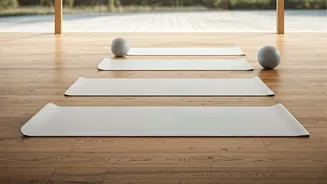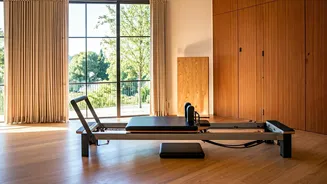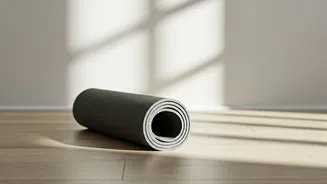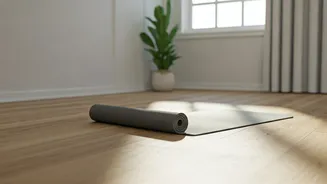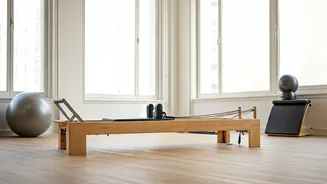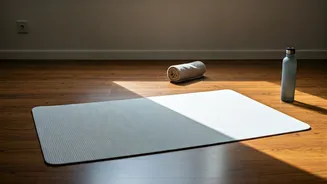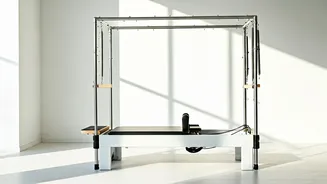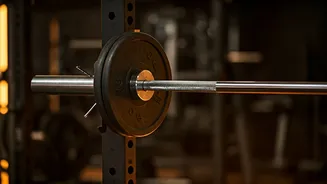Pilates: An Introduction
Pilates, developed by Joseph Pilates, is a system of exercises focusing on core strength, flexibility, and overall body awareness. It emphasizes controlled
movements and proper breathing techniques, making it a low-impact workout suitable for all ages and fitness levels. The beauty of Pilates lies in its versatility; it can be modified to suit individual needs and goals, whether you're a beginner or an experienced athlete. The exercises often involve using your own body weight for resistance, making them easily adaptable to a home environment. Regular Pilates practice improves posture, enhances muscle tone, and increases body awareness, contributing significantly to both physical and mental well-being. Pilates not only strengthens the core muscles but also improves balance and coordination, reducing the risk of injuries and enhancing overall functional fitness. Core strength is the foundation for almost every movement, and a strong core helps stabilize the spine, preventing back pain and improving athletic performance. With consistent effort, Pilates provides a holistic approach to fitness, helping people build lean muscle, improve posture, and alleviate the effects of prolonged sitting or poor movement patterns.
The Hundred
The Hundred is a fundamental Pilates exercise that warms up the body and engages the core. To perform this, lie on your back with your knees bent and feet flat on the floor. Engage your core, gently lift your head and shoulders off the mat, and extend your arms towards the ceiling. Pump your arms up and down, inhaling for five counts and exhaling for five counts, repeating the cycle ten times. Maintain a steady breath and keep your core engaged throughout the exercise. This exercise improves cardiovascular endurance and strengthens the abdominal muscles. The pumping action of the arms creates a rhythmic movement that coordinates with your breath, promoting relaxation and focus. Start with a modified version if you are new to Pilates by keeping your head on the mat and focusing on the arm movements and breathing. Focus on keeping your core engaged to protect your lower back and maximize the benefits of the exercise. With practice, you can increase the intensity by extending your legs and lowering them closer to the floor while maintaining a stable core and breathing smoothly.
Rolling Like a Ball
The 'Rolling Like a Ball' exercise is designed to massage the spine while strengthening the core muscles. Begin by sitting on the floor with your knees bent and feet lifted off the ground, holding your shins with your hands. Round your spine and engage your core, then gently roll backward, keeping your chin tucked toward your chest and your core engaged. As you roll back, maintain the rounded shape, and as you return to the starting position, use your core to control the movement. This exercise stretches the spine, improves balance, and strengthens the abdominal muscles. It also encourages coordination and body awareness. To begin, ensure you have sufficient space around you to roll without hitting anything. Focus on maintaining a rounded spine and using your core to control the movement, not momentum. If it feels challenging, you can modify it by placing your feet on the floor. Breathing deeply helps you control the movement and relax your body, making this exercise an excellent stress reliever.
Single-Leg Stretch
The Single-Leg Stretch focuses on core stability and abdominal strength. Lie on your back with your knees bent and feet flat on the floor. Bring one knee towards your chest and hold it with both hands, while extending the other leg towards the floor. Inhale, then switch legs, drawing the other knee to your chest while extending the first leg. Continue alternating legs, maintaining a steady pace and engaging your core throughout. This exercise targets the rectus abdominis and obliques and helps improve coordination. Keep your lower back pressed into the mat to prevent arching. Your head and shoulders can be lifted for more intensity but ensure you engage your core muscles to protect your neck. Breathing should remain smooth and controlled: inhale as you extend the leg and exhale as you draw the knee to the chest. This exercise, when done regularly, not only strengthens your core but also enhances spinal stability and promotes better posture. It is a fantastic exercise for building a solid foundation of core strength.
Toe Taps
Toe Taps are excellent for engaging the core while focusing on controlled movements. Lie on your back with your knees bent at a 90-degree angle, forming a tabletop position. Engage your core, and gently tap one foot towards the floor, then return it to the tabletop position. Alternate tapping each foot, keeping your core engaged and your lower back pressed into the mat to prevent arching. This exercise improves core stability, coordination, and abdominal strength. It's a low-impact exercise that's suitable for all fitness levels. Ensure you control your movement and maintain stability throughout. Imagine a glass of water on your lower back, and try not to spill it. This will help you focus on engaging your core. Controlled breathing, inhaling as you tap your foot down and exhaling as you return to the tabletop position, helps to stabilize your core. If you find this challenging, start with fewer repetitions and focus on controlled movements before gradually increasing the number of taps.
